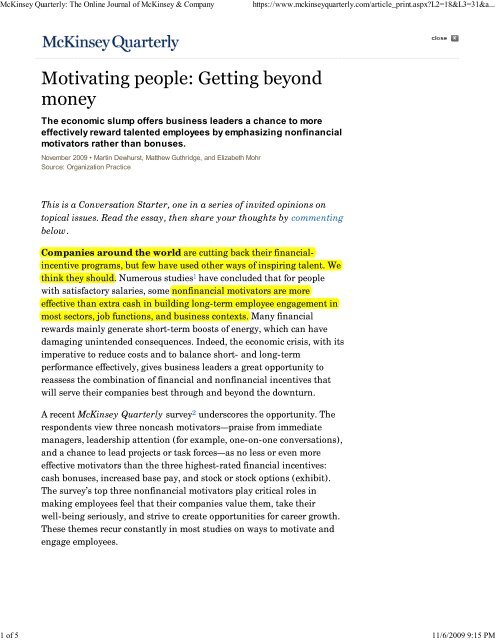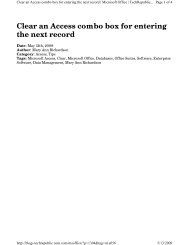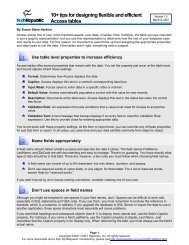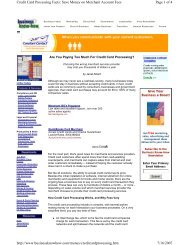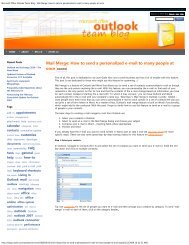McKinsey Quarterly: The Onl... - Cornerstone Business Solutions
McKinsey Quarterly: The Onl... - Cornerstone Business Solutions
McKinsey Quarterly: The Onl... - Cornerstone Business Solutions
Create successful ePaper yourself
Turn your PDF publications into a flip-book with our unique Google optimized e-Paper software.
<strong>McKinsey</strong> <strong>Quarterly</strong>: <strong>The</strong> <strong>Onl</strong>ine Journal of <strong>McKinsey</strong> & Company<br />
https://www.mckinseyquarterly.com/article_print.aspxL2=18&L3=31&a...<br />
1 of 5 11/6/2009 9:15 PM<br />
<strong>The</strong> economic slump offers business leaders a chance to more<br />
effectively reward talented employees by emphasizing nonfinancial<br />
motivators rather than bonuses.<br />
November 2009 • Martin Dewhurst, Matthew Guthridge, and Elizabeth Mohr<br />
Source: Organization Practice<br />
This is a Conversation Starter, one in a series of invited opinions on<br />
topical issues. Read the essay, then share your thoughts by commenting<br />
below.<br />
Companies around the world are cutting back their financialincentive<br />
programs, but few have used other ways of inspiring talent. We<br />
think they should. Numerous studies 1 have concluded that for people<br />
with satisfactory salaries, some nonfinancial motivators are more<br />
effective than extra cash in building long-term employee engagement in<br />
most sectors, job functions, and business contexts. Many financial<br />
rewards mainly generate short-term boosts of energy, which can have<br />
damaging unintended consequences. Indeed, the economic crisis, with its<br />
imperative to reduce costs and to balance short- and long-term<br />
performance effectively, gives business leaders a great opportunity to<br />
reassess the combination of financial and nonfinancial incentives that<br />
will serve their companies best through and beyond the downturn.<br />
A recent <strong>McKinsey</strong> <strong>Quarterly</strong> survey 2 underscores the opportunity. <strong>The</strong><br />
respondents view three noncash motivators—praise from immediate<br />
managers, leadership attention (for example, one-on-one conversations),<br />
and a chance to lead projects or task forces—as no less or even more<br />
effective motivators than the three highest-rated financial incentives:<br />
cash bonuses, increased base pay, and stock or stock options (exhibit).<br />
<strong>The</strong> survey’s top three nonfinancial motivators play critical roles in<br />
making employees feel that their companies value them, take their<br />
well-being seriously, and strive to create opportunities for career growth.<br />
<strong>The</strong>se themes recur constantly in most studies on ways to motivate and<br />
engage employees.
<strong>McKinsey</strong> <strong>Quarterly</strong>: <strong>The</strong> <strong>Onl</strong>ine Journal of <strong>McKinsey</strong> & Company<br />
https://www.mckinseyquarterly.com/article_print.aspxL2=18&L3=31&a...<br />
2 of 5 11/6/2009 9:15 PM<br />
Back to top<br />
<strong>The</strong>re couldn’t be a better time to reinforce more cost-effective<br />
approaches. Money’s traditional role as the dominant motivator is under<br />
pressure from declining corporate revenues, sagging stock markets, and<br />
increasing scrutiny by regulators, activist shareholders, and the general<br />
public. Our in-depth interviews with HR directors suggest that many<br />
companies have cut remuneration costs by 15 percent or more.<br />
What’s more, employee motivation is sagging throughout the world—<br />
morale has fallen at almost half of all companies, according to another<br />
<strong>McKinsey</strong> survey 3 —at a time when businesses need engaged leaders and<br />
other employees willing to go above and beyond expectations.<br />
Organizations face the challenge of retaining talented people amid<br />
morale-sapping layoffs that tend to increase voluntary turnover over the<br />
medium term. Often, top performers are the first to go. Strong talent<br />
management is critical to recruit new ones from, for example, the<br />
financial sector, who have been laid off from their employers or feel<br />
disenchanted with them.<br />
Yet while 70 percent of organizations have adjusted their rewardand-motivation<br />
programs during the past 12 months or plan to do so,<br />
relatively few have gone beyond the direct management of costs.<br />
Two-thirds of the executives we surveyed cited cost reductions as one of<br />
the top three reasons for the changes; 27 percent made changes to<br />
increase employee motivation; and only 9 percent had the goal of<br />
attracting new talent. Regional differences were striking. Forty-five<br />
percent of the respondents in developing markets, where economies have<br />
proved more robust, cited employee motivation as a key reason for<br />
modifying incentives, compared with only 19 percent in the United States<br />
and Western Europe, where the crisis hit hardest.
<strong>McKinsey</strong> <strong>Quarterly</strong>: <strong>The</strong> <strong>Onl</strong>ine Journal of <strong>McKinsey</strong> & Company<br />
https://www.mckinseyquarterly.com/article_print.aspxL2=18&L3=31&a...<br />
3 of 5 11/6/2009 9:15 PM<br />
Even though overall reliance on financial incentives fell over the past 12<br />
months, a number of companies curtailed their use of nonfinancial ones<br />
as well. Thirteen percent of the survey respondents report that managers<br />
praise their subordinates less often, 20 percent that opportunities to lead<br />
projects or task forces are scarcer, and 26 percent that leadership<br />
attention to motivate talent is less forthcoming.<br />
Why haven’t many organizations made more use of cost-effective<br />
nonfinancial motivators at a time when cash is hard to find One reason<br />
may be that many executives hesitate to challenge the traditional<br />
managerial wisdom: money is what really counts. While executives<br />
themselves may be equally influenced by other things, they still think<br />
that bonuses are the dominant incentive for most people. “Managers see<br />
motivation in terms of the size of the compensation,” explained an HR<br />
director from the financial-services industry.<br />
Another reason is probably that nonfinancial ways to motivate people do,<br />
on the whole, require more time and commitment from senior managers.<br />
One HR director we interviewed spoke of their tendency to “hide” in their<br />
offices—primarily reflecting uncertainty about the current situation and<br />
outlook. This lack of interaction between managers and their people<br />
creates a highly damaging void that saps employee engagement.<br />
Some far-thinking companies, though, are working hard to understand<br />
what motivates employees and to act on their findings. One global<br />
pharmaceutical company conducted a survey that showed that in some<br />
countries employees emphasized the role of senior leadership; in others,<br />
social responsibility. <strong>The</strong> company is now increasing the weight of<br />
engagement metrics in its management scorecard so that they are seen as<br />
core performance objectives. One biotech company has reframed the<br />
incentives issue by putting the focus on “recognition” instead of “reward”<br />
in order to inspire a more thoughtful discussion about what motivates<br />
people.<br />
<strong>The</strong> top three nonfinancial motivators our survey respondents cited offer<br />
guidance on where management might focus. <strong>The</strong> HR directors we spoke<br />
with, for example, emphasized leadership attention as a way to signal the<br />
importance of retaining top talent. When one global pharma company’s<br />
CEO was crafting corporate strategy this year, he convened several focus<br />
groups of talented managers to generate ideas about how to create more<br />
value for the business. With the same aims, a leading beverage company<br />
asked every executive committee member to meet with the critical people<br />
in their own product groups.<br />
“One-on-one meetings between staff and leaders are hugely<br />
motivational,” explained an HR director from a mining and basic-
<strong>McKinsey</strong> <strong>Quarterly</strong>: <strong>The</strong> <strong>Onl</strong>ine Journal of <strong>McKinsey</strong> & Company<br />
https://www.mckinseyquarterly.com/article_print.aspxL2=18&L3=31&a...<br />
4 of 5 11/6/2009 9:15 PM<br />
materials company—“they make people feel valued during these difficult<br />
times.” By contrast, our survey’s respondents rated large-scale<br />
communications events, such as the town hall meetings common during<br />
the economic crisis, as one of the least effective nonfinancial motivators,<br />
along with unpaid or partially paid leave, training programs, and flexible<br />
work arrangements. While communication is critical, attempts to convey<br />
messages about the state of the business often have some spin, one HR<br />
director told us.<br />
A chance to lead projects is a motivator that only half of the companies in<br />
our survey use frequently, although this is a particularly powerful way of<br />
inspiring employees to make a strong contribution at a challenging time.<br />
Such opportunities also develop their leadership capabilities, with<br />
long-term benefits for the organization. One HR director in the basicmaterials<br />
industry explained that involvement in special projects “makes<br />
people feel like they’re part of the answer—and part of the company’s<br />
future.” A leading company from the beverages industry, for example,<br />
selected 30 high-potential managers to participate in a leadership<br />
program that created a series of projects designed and led by the<br />
participants. “Now is the time to swim upstream and invest more in our<br />
high potentials,” said the HR director, when launching the program this<br />
year.<br />
With profitability returning to some geographies and sectors, we see<br />
signs that bonuses will be making a comeback: for instance, 28 percent of<br />
our survey respondents say that their companies plan to reintroduce<br />
financial incentives in the coming year. While such rewards certainly<br />
have an important role to play, business leaders would do well to<br />
consider the lessons of the crisis and think broadly about the best ways to<br />
engage and inspire employees. A talent strategy that emphasizes the<br />
frequent use of the right nonfinancial motivators would benefit most<br />
companies in bleak times and fair. By acting now, they could exit the<br />
downturn stronger than they entered it.<br />
About the Authors<br />
Martin Dewhurst is a director in <strong>McKinsey</strong>’s London office, where Matthew Guthridge is an associate principal and<br />
Elizabeth Mohr is a consultant.<br />
Back to top<br />
Notes<br />
1 John Gibbons, Employee Engagement: A Review of Current Research and Its Implications, Conference Board, 2006.<br />
2 <strong>McKinsey</strong> <strong>Quarterly</strong> conducted the survey in June 2009 and received responses from 1,047 executives, managers,<br />
and employees around the world. More than a quarter of the respondents were corporate directors or CEOs or other<br />
C-level executives. <strong>The</strong> sample represents all regions and most sectors.<br />
3 “Economic Conditions Snapshot, June 2009: <strong>McKinsey</strong> Global Survey Results,” mckinseyquarterly.com, June 2009.
<strong>McKinsey</strong> <strong>Quarterly</strong>: <strong>The</strong> <strong>Onl</strong>ine Journal of <strong>McKinsey</strong> & Company<br />
https://www.mckinseyquarterly.com/article_print.aspxL2=18&L3=31&a...<br />
5 of 5 11/6/2009 9:15 PM<br />
© Copyright 1992-2009 <strong>McKinsey</strong> & Company


